Best Belt Sander
To many people, the best belt sander is just a great power tool that they know primarily from television gags, their handyman friends, or maybe that one time they tried to help a friend finish a hardwood floor. For most day-to-day applications, the size, power, and capability of a belt sander can be superfluous, and like all power tools, they require training, effort, and respect in order to be used safely and correctly. But that doesn't mean you should shy away from owning one, especially if you plan on regularly doing your own woodwork, carpentry, or other home repairs. A belt sander is the only surefire way to efficiently make a smooth wooden surface and to ensure that splinters are not a concern.
What’s a belt sander?
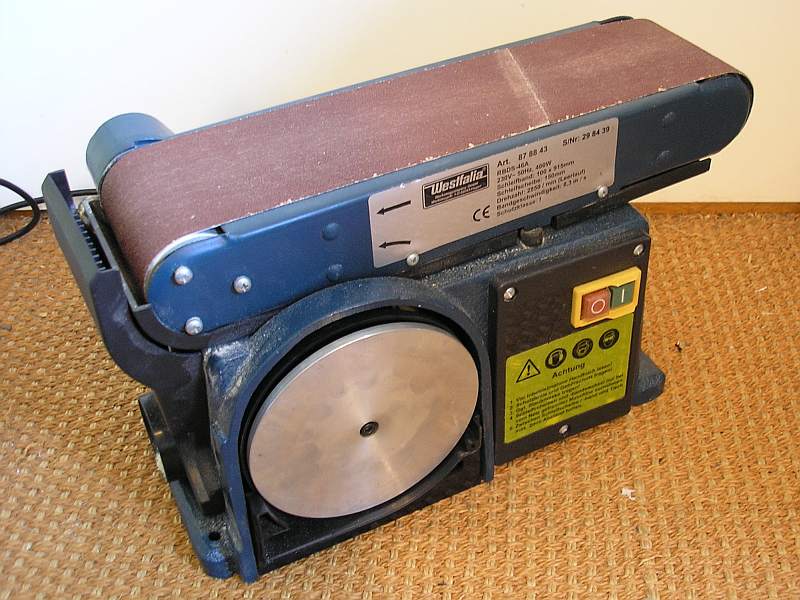
In short, it is a pair of large rollers which propels a belt of sandpaper at a speed controlled by the user. This enables the sandpaper to work on the material in a single direction and to apply a constant friction, helping to eliminate imperfections and unevenness in wood. It is, in effect, a very high powered application of traditional sandpaper, which enables the user to effect massive change on a surface in a small amount of time. The even nature of the belt also helps ensure that its use does not dig channels or other imperfections into the wood while it works, and infinite adjustability in terms of belt type and belt speed allow the user to have precise control over how much material he is removing from the wood.
Sanding belts comparison chart
Image | Product name | Noise | Weight | |
|---|---|---|---|---|
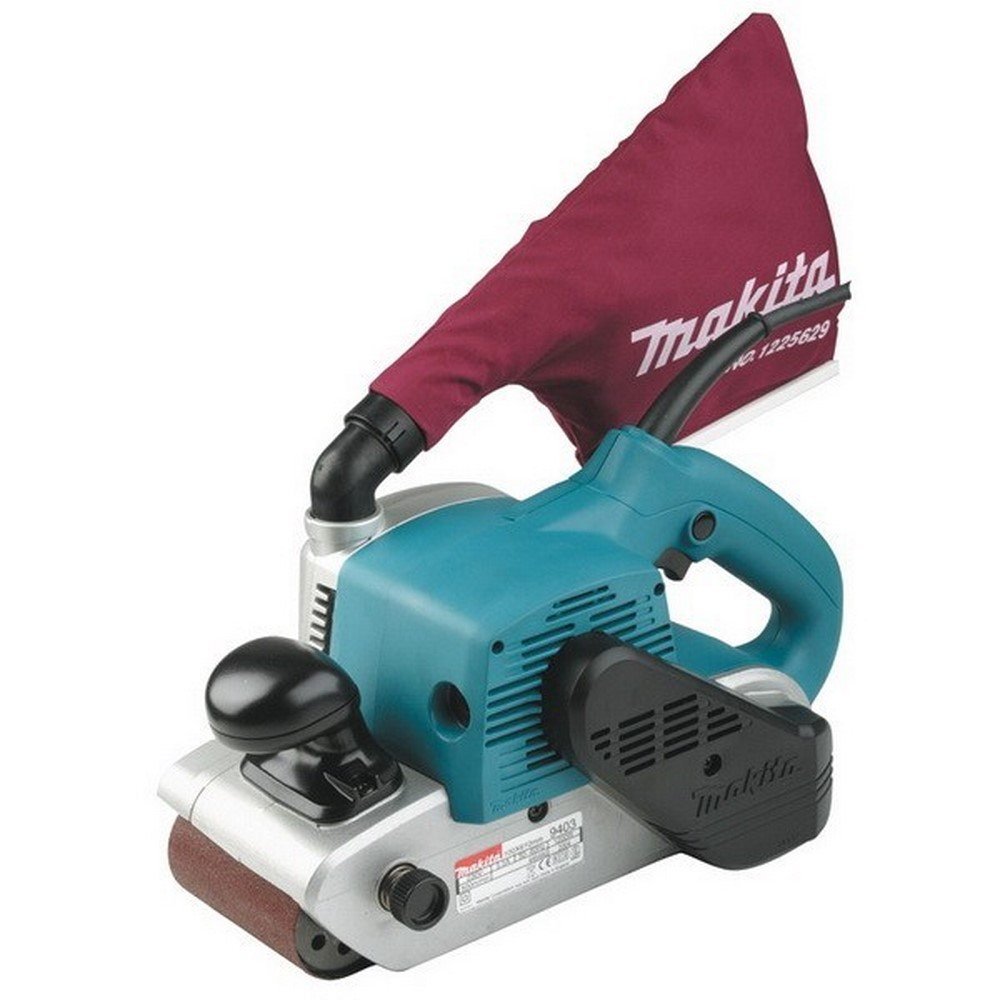
| Makita 9403 4" x 24" Belt Sander with Cloth Dust Bag Editor's choise | 83 dB | 13 pounds | |
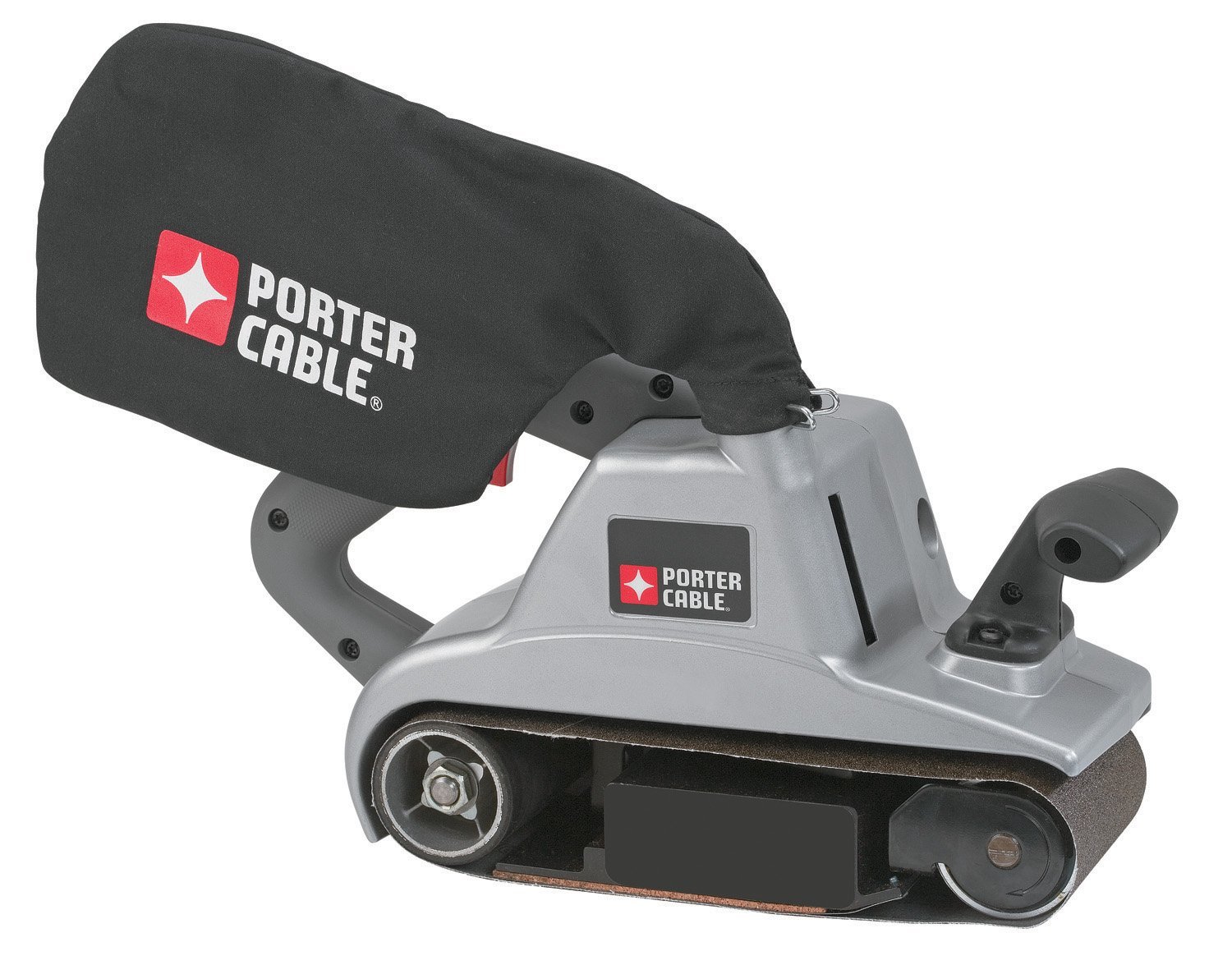
| PORTER-CABLE 362V 4-Inch by 24-Inch Variable Speed Belt Sander | N/A | 16 pounds | |
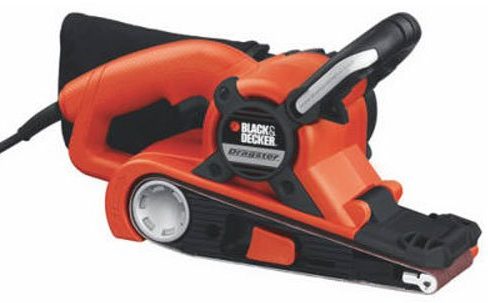
| Black & Decker DS321 Dragster 7 Amp 3-Inch by 21-Inch Belt Sander with Cloth Dust Bag | N/A | 8.2 pounds | |
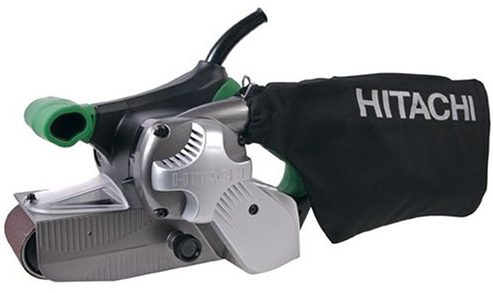
| Hitachi SB8V2 9.0 Amp 3-Inch-by-21-Inch Variable Speed Belt Sander with Trigger Lock and Soft Grip Handles | N/A | 9.5 pounds | |
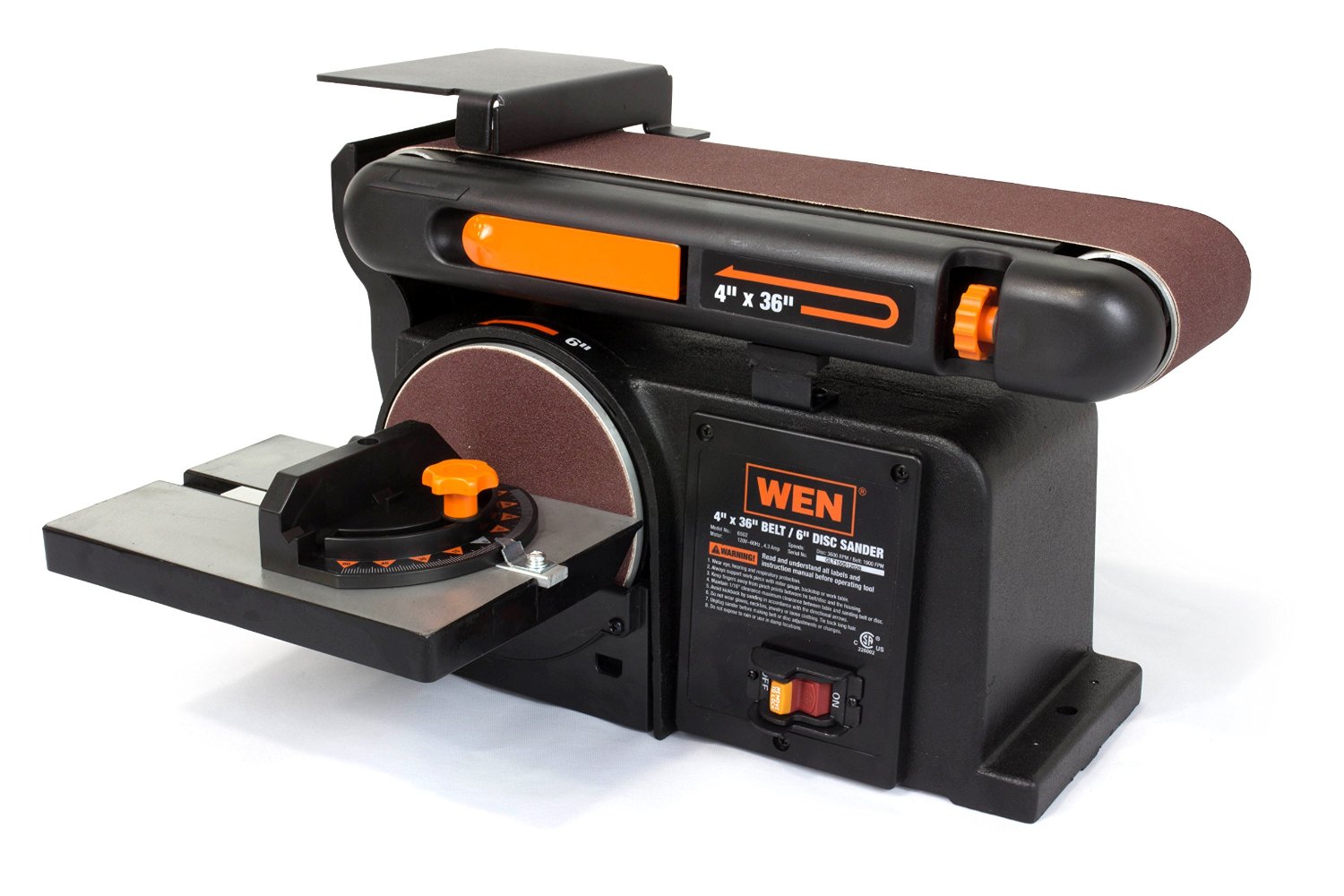
| WEN 6502 4 x 36-Inch Belt and 6-Inch Disc Sander with Cast Iron Base | N/A | 40 pounds |
Best belt sander: what's it used for?
A belt sander is an electric tool used for furniture carpentry, stripping paint off of surfaces or flattening a floor, all of these in just a matter of minutes. A common use of a belt sander in carpentry is to remove all those splinters that make the wood look imperfect.
Stationary or mobile belt sanders

There are both stationary and mobile belt sanders, enabling the user to either apply the sander to a surface or apply the surface to a sander. Each one has its own use and is designed to enable the craftsman to accomplish a certain task.
Just as a large table sander is ideal for rough finishing work on cabinets, chair backs and curved pieces of wood, it is less than ideal for fine work on delicate work or for pieces of wood that are too large to be easily manipulated.
Therefore, before buying or renting a belt sander for any task, always begin by asking yourself exactly what sort of task you want to accomplish, and what type of attributes would be best for performing that task.
Picking the best belt sander for you
Having so many models of belt sanders on the market make it a difficult task to pick the right one for you and your needs. A list of things you must consider before making your decision includes:
- Weight - the heavier it is, the more difficult it will be to use it on vertical surfaces.
- Power - powerful tools are more dangerous.
- Size - bigger sanders will be difficult to use.
- Shape - this contributes a lot to the versatility of the sander.
- Speed - the faster the sander is, the quicker you’ll finish your work.
- Dust collecting - a sander without this feature is not that good.
- Comfort.
Why weight matters in a belt sander?
A large, heavy sander will be difficult to maneuver, and as your arms get tired, you will be more and more likely to make a mistake.
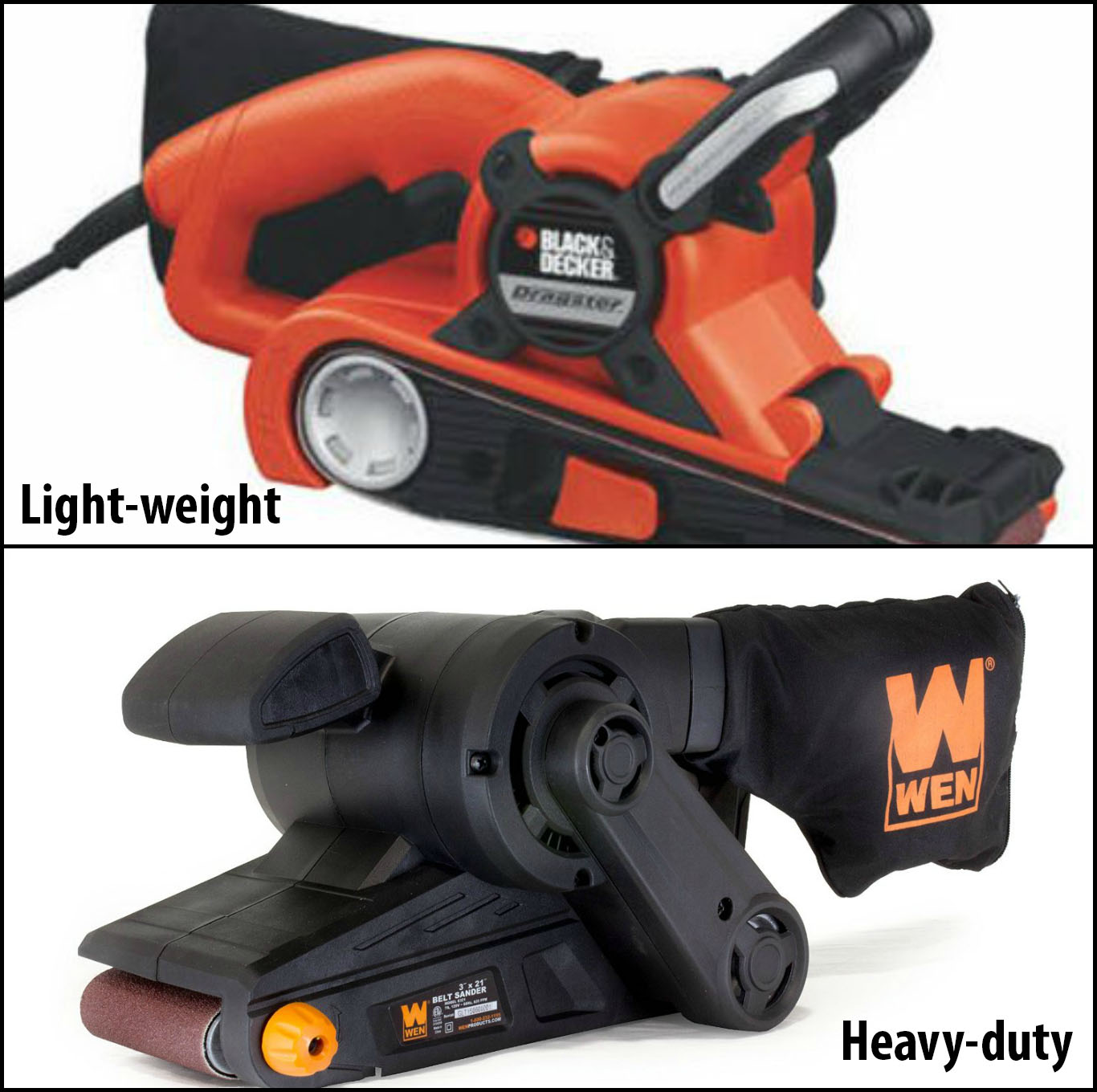
While many errors can be corrected in wood, it is important to remember that you will always be removing material, not adding it, and the application of excessive sanding will result in you needing to start all over again, as a piece has been sanded down to the point of uselessness.
The most common errors involving the best belt sander occur when the belt sander slips, either because the operator grows tired and lets it slip, or when the operator attempts to apply more weight to it and in so doing causes it to dig into the wood below.
Ideally, the weight of the belt sander itself should be doing most of the work, unless you are working on a vertical surface.
Therefore, the heavier the job, the heavier the machine.
Alternatively, if you are using a stationary sander, it is best to think of the weight of what you will be manipulating instead.
You will want to make sure that whatever portion of the surface you are working on that is touching the sander is within your control.
Therefore it's best to use a sander that is only as wide as you can control, and moving at a pace that will not pull the piece you are working on from your hands.
Is power really important?
While every handyman is tempted to simply get the most powerful machine they can, the need for careful control and gentle throttle movements means that even a slight excess of power can cause a belt sander to run away from you or destroy what you have been working on.
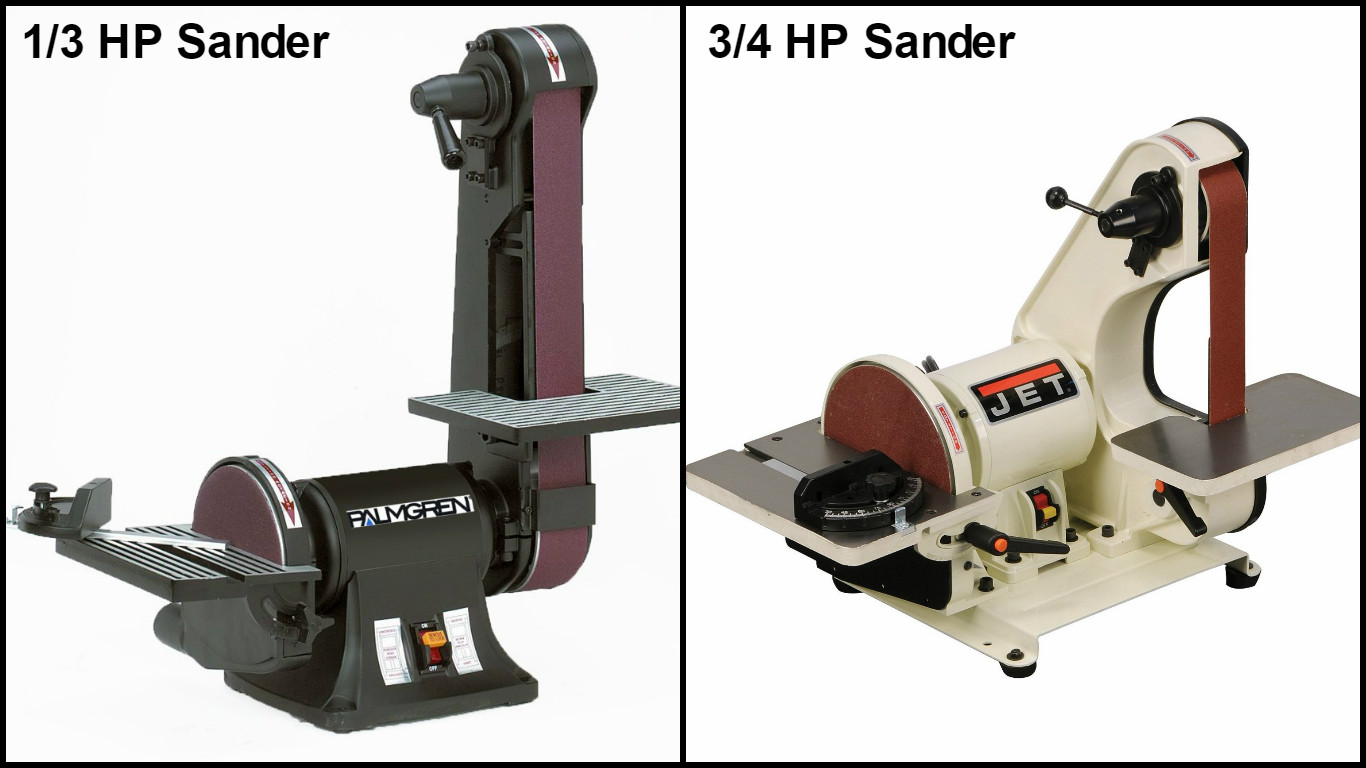
After all, there is a reason that fun-loving handymen conduct belt sander drag races: the speed of the belt, in particular on a more powerful unit, can send a belt sander flying, and the high surface area and friction of the belt means that it can grip astonishingly well.
It is, therefore, important to purchase or rent the best belt sander which has the right amount of power for the job.
Fortunately, most modern belt sanders have very generous throttles, especially those intended for novice users.
Indeed, some of the most high-end models have adjustable throttles, enabling different speed ranges depending on the job at hand and the user's comfort with keeping the sander under control.
However, that does not mean that a novice user can pick up the most powerful unit he or she can find and then rely on the machine to limit its power appropriately.
The best rule of thumb is to see how much power you need, and then buy less than that.
Odds are you will be surprised at how powerful even the tamest belt sanders are, and one or two runaway incidents will teach you the importance of proper throttle control.
Size
While this is somewhat related to weight, since the units are designed to use their own weight to apply much of the friction, individual machines are designed to weigh more or less, or to make it easier or harder for an operator to intentionally (or unintentionally) add their own body weight to the machine as they work.
Size is also essential for fitting into spaces you may need to reach for full and even coverage, especially when dealing with small objects and tight spaces.
Specialized sanders exist for unusual situations, but the odds are that smaller "pocket" sanders can do most of the work in tight places, while you'll want to rely on much larger units for floors, walls, ceilings, and other large spaces.
Make sure that whatever you're getting is not too big, nor is it too small.
After all, a device that is exhausting to use because it was never intended to work over such a wide area can lead to mistakes just as surely as an overlarge machine can fail to fit into tight corners.
Shape
The design and shape of belt sanders have increasingly become uniform, it's still important to understand how your belt sander will fit into the physical area of your project.
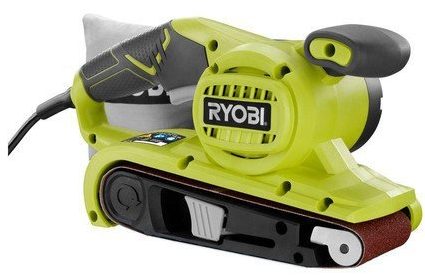
Are there any low clearances that it will need to clear?
If you push the sander into such an area, will you be able to properly hold and control it in your hands?
When holding the unit, does it have proper ergonomics for the method you intend to use?
This last issue has been an area of significant development in recent years, especially with our improved understanding of how good ergonomics reduces injuries and increases effectiveness.
If at all possible, it is a good idea to pick up a display or rental model and determine how it feels in your hands.
The best belt sander will have a comfortable feel that will be crucial to you if you have a large job to do, and even minor levels of discomfort can lead to pain or injuries over time.
Make sure too that you are holding it correctly, both so that you can control it with maximum efficacy and that it never has a chance to get away from you.
Speed – Variable or Fixed?
It is important to understand what the speed of a belt sander truly means.
Just like the power mentioned above, the speed of a belt sander is a common way that many beginning users get themselves into trouble.

A belt that is moving too fast to be controlled can damage the wood, cause the sander to fly off away from you, or worse, lead to personal injury.
Before picking out a sander, talk to other users about what speeds they use on what surfaces and to achieve what results.
While the belt itself and its makeup certainly pay an important role here, understanding the rate at which that belt is moving and the amount of wood it is removing is key to producing a nice, even surface without any dips or rises.
The best belt sander and some of the more advanced modern units have, in addition to the throttle, digital speed controls which enable you to pick a speed or a speed range and then stick with it.
They can also tell you the actual speed of the sander, thus eliminating guesswork and the need to estimate via feel.
Some belt sanders comes with one fixed speed, this means that you just turn on or off the sander, the speed at which its operating can’t be adjusted further than that.
The belt
There will always be a condition of feel in the best belt sander, and that condition is very dependent on the belt.
There is a dizzying array of belts available, each designed for specific tasks.
- Larger, coarser belts are intended for rough work
- Finer belts may be so fine as to be barely detectable as sandpaper, suited for smooth finishing
- Rougher belts will remove more material more quickly, but this increased power can quickly lead to mistakes if not carefully monitored and gently applied
However, a rougher belt is necessary when dealing with large jobs or very rough cuts of wood.
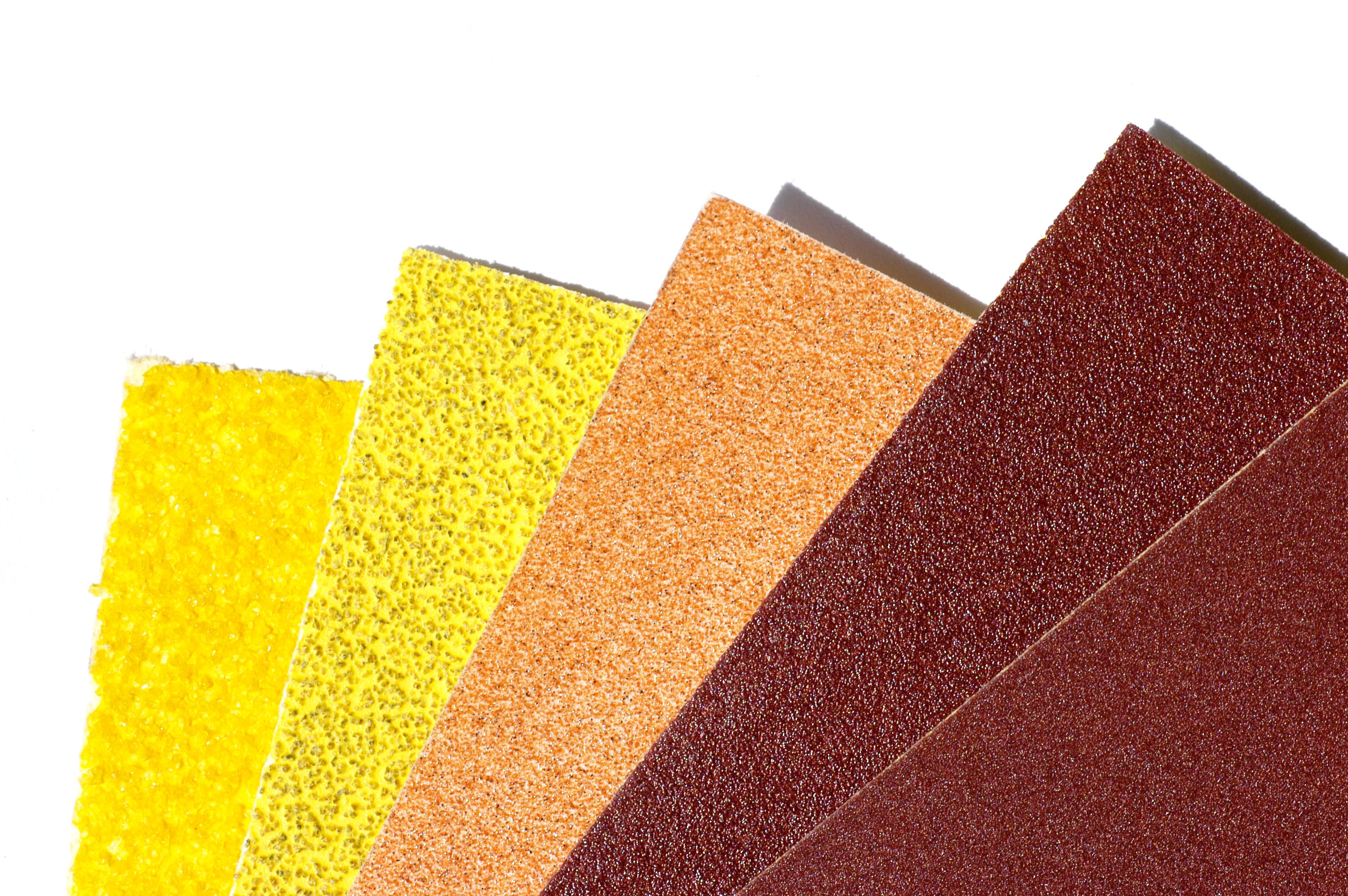
Different types of sandpapers
Most notably, coarse belts are best when working with wood that has not been trimmed by a lumber company, or has become warped and needs to be ground down in order to be level again.
Finer grains are used for touch-up work and for making wood as smooth as possible.
Odds are over the course of the job you will need to replace the belt a few times, switching to finer and finer grains as you complete the project.
Replacing the belt
It is necessary to make sure that the belts are both easy to replace and that, once installed, they are held securely on the best belt sander.
An improperly secured belt can go flying off, while one which is too tight will suffer excess stress and break apart.
Both cases can result in injuries, as well as setting you back while you either reset or replace the belt.
Familiarize yourself with how the belt is installed and removed, and make sure that any locking mechanisms on the machine stay locked and provide the belt with the proper amount of tension (see the video below for more details).
Make sure as well that the belt is designed for your model.
Modern belts are standardized, with most machines accepting the same type of belt, but a little too much or too little tension can be caused easily.
Some sanders have the ability to adjust the tension on the belt, although with modern standardization this has become increasingly rare.
If your sander is adjustable, make sure to follow the instructions in order to get the proper amount of tension on the belt.
Ideally, it should only take a few minutes to change a belt, and most modern systems are very intuitive.
Therefore, if possible, you should practice removing and reinstalling a belt before purchase, to ensure you know how to do so and that you find it easy.
Dust collecting
Of course, the belt is going to create a bunch of sawdust, and the best belt sander surely will have a dust collecting system in place.
The amount of sawdust produced by a belt sander, especially a large one using a coarse belt, can be overwhelming.
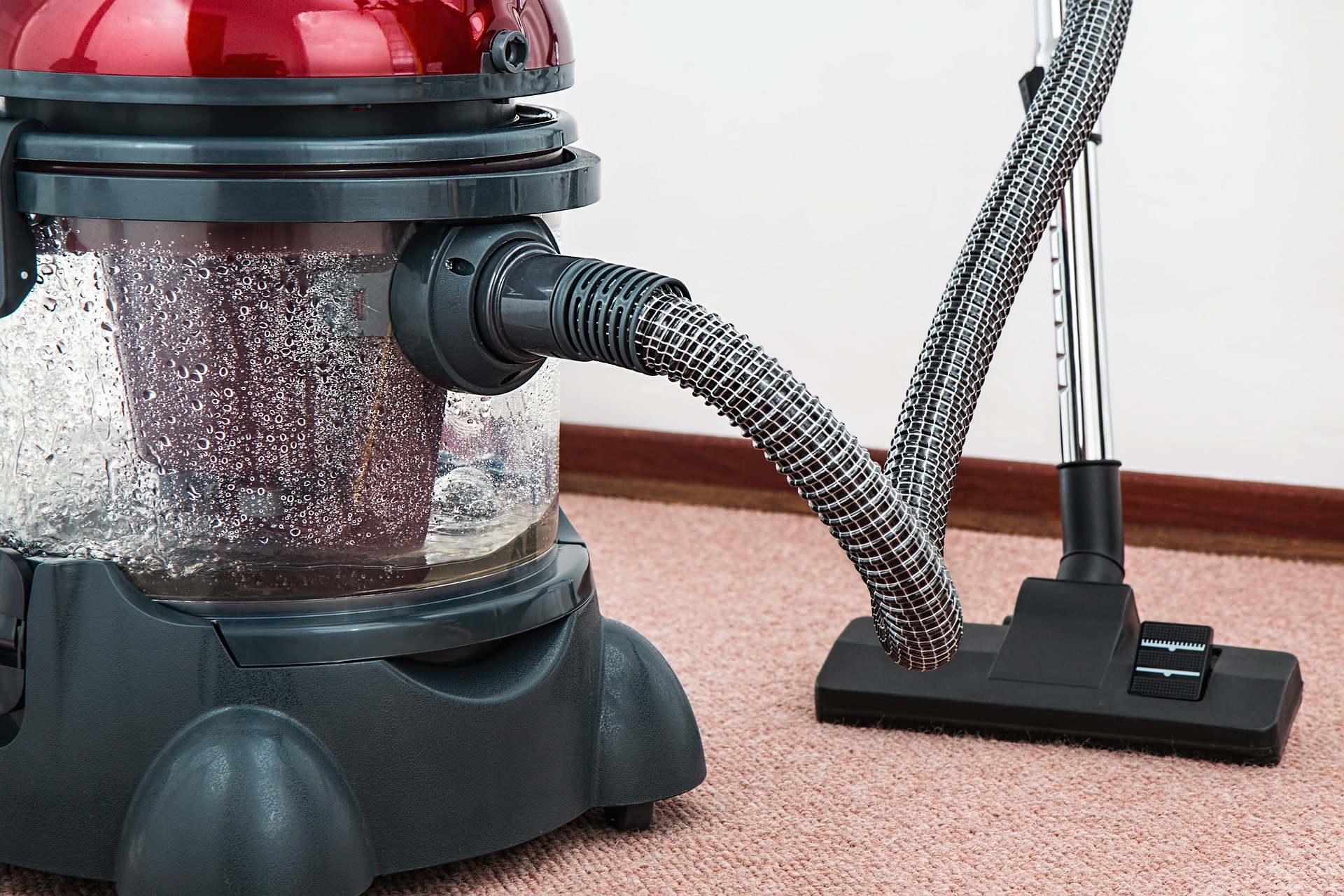
Only a few minutes of sanding with a belt sander can produce as much sawdust as hours of work with any hand tool.
It is, therefore, important that whatever belt sander your choose has some means of handling this dust.
Older units and small hand units will just eject the dust, although this is only suitable for fine touch-ups and small areas, where the amount produced can easily be controlled and rapidly be removed by hand or a small vacuum.
Modern units have some form of dust catcher, but the best units have an onboard vacuum that sucks the sawdust into a receptacle.
These not only eliminate the hazard of inhaled or unintentionally ignited sawdust, but they also reduce the total time you will be working on a project by reducing cleanup time.
This makes them a very attractive option, and improvements in technology mean that they work better and are available on more, smaller machines.
Some machines come with a basic bag, but can be upgraded to a vacuum later if you choose.
Comfort
One final concern is the overall comfort, especially regarding handle ergonomics.
The best belt sanders will be super comfortable to use, no matter the job you're doing.
It's impractical to construct a bespoke unit for every customer, so odds are your machine will not be perfect in your hands.

However, that does not mean it should not feel right, or even extremely comfortable.
Most machines are built to accommodate the average person, so if you are unusually short or tall you may have trouble, and might want to get a larger or smaller machine to compensate.
As you will need to exert such careful control over the machine to avoid sanding away too much, it may be worth it to buy a smaller machine and just run it longer, as opposed to trying to wrestle with a larger machine.
If possible, use the machine some before purchasing, either by renting it or borrowing it from a friend.
Even carrying it around the store may prove useful, since in so doing you can determine if it feels unnatural in your hands, or is too heavy for you to comfortably carry or manipulate over time.
Be careful and don’t choose a cheap sander
You should make sure that the machine has been built well, and also be sure that the best belt sander won't be cheap.
Rapid advances in technology, combined with expensive manufacturing, have resulted in a significant number of cheap tools flooding the market.
While this is certainly good for your pocketbook, it increases the odds that you'll end up with something that is too flimsy for your needs.
A small, cheap unit might be ideal for doing some remedial carpentry on old furniture, but it won't be able to cope with the long, hard hours necessary to remove paint from a wall or flatten a floor, countertop or tabletop.
Read online reviews for the model and also exercise common sense.
An inexpensive handheld model will be ideal for the casual weekend project, but it will be useless if you intend to do major restoration work.
You should also make sure that your model has a reputation for excellent build quality and longevity.
Belt sander models do not come out very often, and so getting one that has been on the market for a few years will enable you to get one that has been tested in the real world, and found to function well.
Belt sander safety tips
Whatever model of belt sander you choose, be aware of the need to be safe around it just like with any power tool.
- Belt sanders present unique risks, and while they are much safer than table saws or angle grinders, they can still blind, skin, maim and bruise if not handled properly.
- Belt sanders present unique risks, and while they are much safer than table saws or angle grinders, they can still blind, skin, maim and bruise if not handled properly.
- This dust can easily get into your eyes, blinding you or worse, scraping the surface of your eye.
- As such, eye protection is much more important when handling belt sanders than with other power tools.
- When using a very fine grain, it may also be prudent to wear a face mask, to prevent you from breathing in wood powder.
- The accumulation of the dust can also present a fire hazard, so plan on cleaning up the dust regularly, and have appropriate receptacles available for storage of the dust.
- Never operate a belt sander above shoulder height, to prevent dust from being kicked into your face. If you are using a belt sander to remove paint, a full face mask is recommended, especially if there is a risk that the paint may contain lead.
Other injuries involving sanders usually include a person's body coming into contact with the belt.
Being aware of where the sander is in relation to your hands and arms is important, as is wearing long-sleeved clothing, full-length pants, and work gloves.
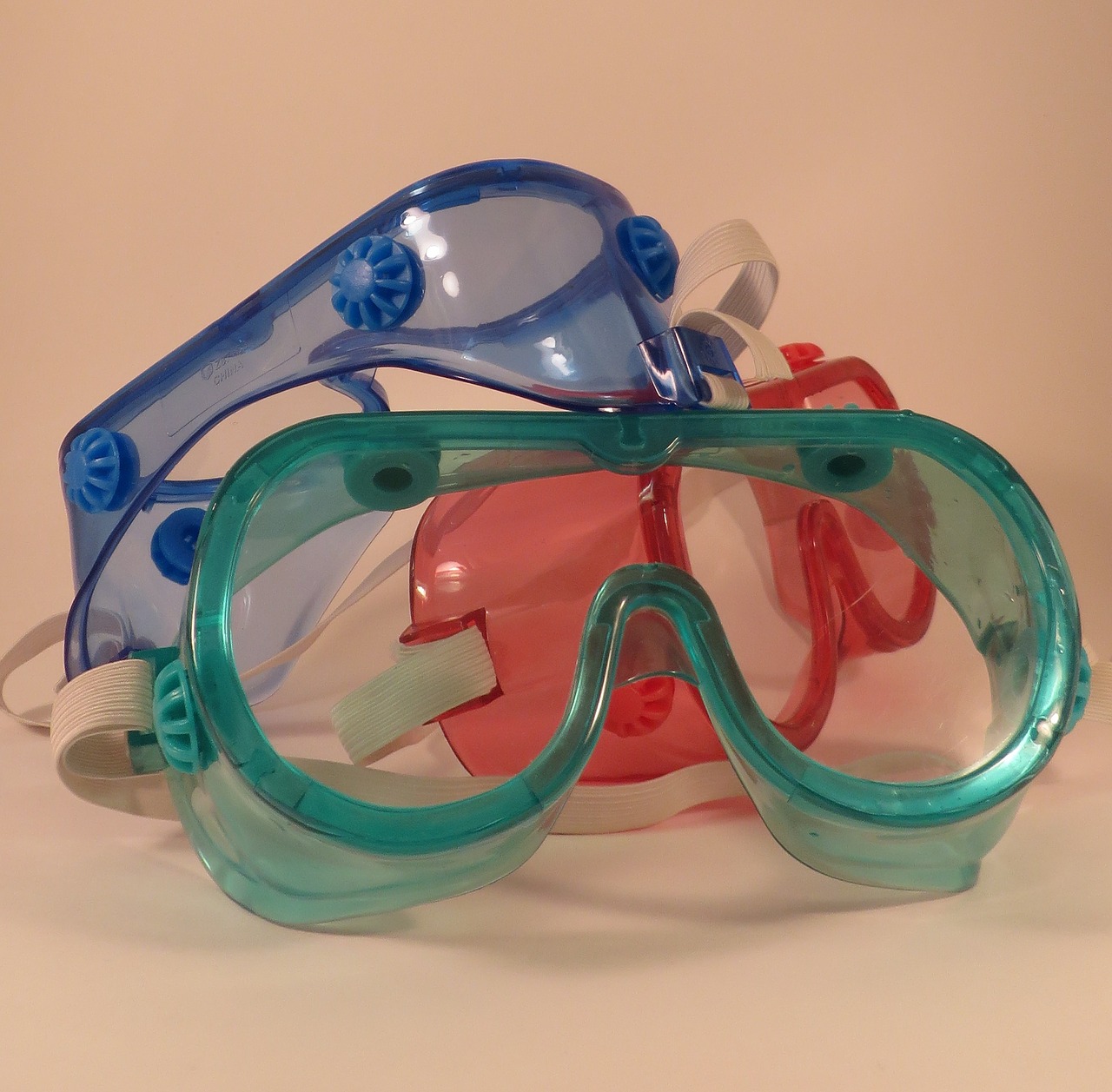
The gloves need not be thick, as they will not need to protect the hands from crushing injuries, but they need to be complete, so as to prevent exposure of the fingers to the moving belt.
Most modern sanders require constant throttle application in order to function, and will stop if you do not constantly apply the throttle, so keeping both hands on the top of the machine is the best way to avoid having your digits sucked into the machine.
Lastly, never sand against the grain of the wood.
This will cause the sander to catch on the grain and may jerk it out of your hands.
Modern sanders will shut off once out of your direct control, but the momentum of a large sander may do damage even without power.
Be aware of those around you, since even brief contact with the sandpaper belt can cause massive skin injuries.
Pro TIP
One of the most important things to consider when buying a belt sander is the belt adjusting mechanism. The majority of the problems with these powered machines is that when the belt is not well adjusted it can fly off away from you. Sometimes causing injuries.
Top 5 Best Belt Sanders
1. Makita 9403 4" x 24" Belt Sander with Cloth Dust Bag

The Makita 9403 is an excellent small sander suitable for most projects.
Neither too big for furniture work nor too small for table surfacing, it is ideal for the home handyman who knows he will need to do a significant amount of sanding in a small amount of time.
It's "above the belt" design enables the operator to get it flush with vertical surfaces such as walls, making it ideal for touch-up work.
The two-handle system offers superior control of the sander, and the 83 dB motor will keep you from annoying the neighbors, although ear protection is still highly recommended. The "labyrinth" style structure of the interior is designed to minimize the entry of dust into the machine.
This ingenious layout will not only increase the longevity of the device, but it will reduce the likelihood that dust accumulation will reduce performance over time.
Further dust control is provided by the cloth bag, which will capture the vast majority of wood dust particles produced by the machine, although face protection is still recommended.
The bag can be rotated 360 degrees or even moved back via an extension hose to maximize comfort and utility.
2. PORTER-CABLE 362V 4-Inch by 24-Inch Variable Speed Belt Sander

The Porter Cable 362V belt sander is an excellent heavy-duty belt sander for contractors and dedicated hobbyists who will be doing a lot of sanding in a small amount of time.
At 12 amps of power, the motor in the 362V is capable of removing significant amounts of material quickly, and its flush design enables the operator to work right along the edge of any surface if need be.
Speed is adjusted by a dial, as opposed to trigger pressure, allowing consistent and even sanding even by new users.
The two-grip design enables the operator to have excellent control, and its ambidextrous layout allows both right and left handed operators to use the machine with equal ease.
The belt-changing lever and tracking knob allow quick and easy replacement of worn belts, as well as enabling the operator to change grains quickly as needed.
The all-metal design increases durability and longevity, making this an ideal choice for dedicated carpenters.
The oversized bag can go for long periods without having to be changed, and can pick up the vast majority of the dust produced, reducing cleanup time.
3. Black & Decker DS321 Dragster 7 Amp 3-Inch by 21-Inch Belt Sander with Cloth Dust Bag

The Black and Decker DS321 Dragster is designed primarily for touch-up work, restoration projects, and other situations where fine control is required.
The "Dragster" design places a significant portion of the belt in front of the machine on a narrow lip, enabling the DS321 to reach into and sand hard-to-reach pieces of wood, unusual jigsaw cuts, and other challenging projects.
It is thus an excellent choice for working with unfinished or recovered furniture, banisters, and other carved pieces.
The unique "lip" enables you to sand using the top of the belt as well as the bottom, giving the operator additional options when handling unusual layouts.
Despite the unique design, it uses standard belts, and replacement of the belt is easy. The design enables flush sanding against walls and corners as needed.
The seven amps of power are more than enough for most light woodwork, and the three-grip handle allows users to comfortably operate it in a large variety of ways, as well as enabling both right and left handed operators.
The cloth bag will remove most of the resulting dust, although eye protection is still required.
4. Hitachi SB8V2 9.0 Amp 3-Inch-by-21-Inch Variable Speed Belt Sander with Trigger Lock and Soft Grip Handles

The Hitachi SB8V2 is an excellent option for both dedicated contractors and casual woodworkers.
The variable speed dial enables users to have superior control without the finesse required of variable speed triggers, and the two-handle design allows operators to control the sander better when working in tight areas.
Elastomer grips enable more secure grip, for superior handling even with a light touch.
Optimized for right-handed users, the dust bag has a narrow profile and is placed on the left, enabling the operator to more fully operate the machine on its right side when working against a flush surface.
The tracking window allows the operator to see better what is going on with the wood and the belt as he works and to change behavior in the event of a problem arising quickly.
It fits most standard sized belts and is designed for quick and easy changing, with proper refinements to ensure the tracking remains consistent.
The belt is driven by a wear-resistant v-belt for superior longevity, making the Hitachi SB8V2 an excellent tool for long-term use.
5. WEN 6502 4 x 36-Inch Belt and 6-Inch Disc Sander with Cast Iron Base

The WEN 6502 is a tabletop belt sander intended for use by dedicated contractors and craftsmen.
Coming with both a belt and disc sander, it is ideal for numerous small pieces, primarily touch-up works designed for use with small pieces of wood.
The sturdy cast-iron base can be mounted to most work benches, although it is light enough to be moved to a particular job site and placed there.
Both belts tilt up to 90 degrees, enabling the operator to grind a large number of distinct surfaces.
The layout and design are ideal for carving flush, matching joints to ensure optimum connection before gluing.
Both the belt and the disc can easily be removed to replace worn sandpaper or change grit. The 1/2 horsepower motor is powerful enough for most home tasks.
A dust-collection port enables an optional dust collector to be attached to reduce cleanup time and improve worksite cleanliness.
The grinding disc has an attached table and miter gauge for precision work, ideal for mass production of small or decorative pieces.
Blade guards provide superior safety and keep fingers, hair, and clothing from being sucked into the machine.
Conclusion
Buying a new sander, especially if you intend on using it for many years, will take a lot of time, research and effort.
But if you put in the proper effort, it will be a useful friend to you for years.
Most carpenters enjoy using the best belt sanders since their tactile feel, and smooth movements can be relaxing, as well as enable them to quickly produce large, continuous changes to a piece of wood in only a few minutes.
Careful selection of a machine that suits you well will enable you not only to complete sanding tasks quickly and safely but with a maximum of comfort and satisfaction.
